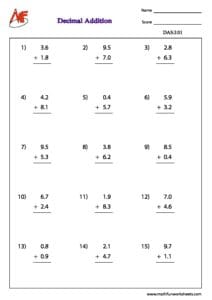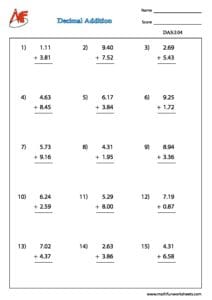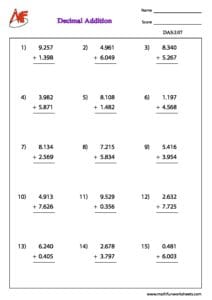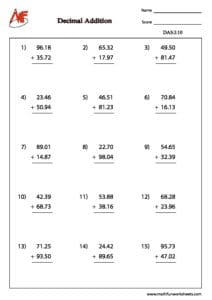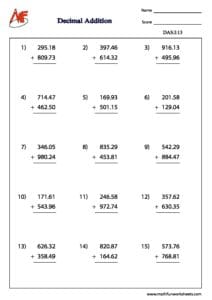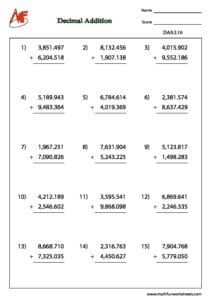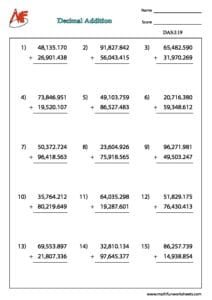- Home
- Numbers & Operations
- Decimal Addition
Browse by Topics
- English Worksheets
- Science Worksheets
- Kid's Corner
- Numbers & Operations
- Addition
- Subtraction
- Multiplication
- Division
- Decimals
- Place Value
- Roman Numerals
- Skip Counting
- Odd & Even Numbers
- Patterns
- Cardinal & Ordinal Numbers
- Rounding Numbers
- Estimation of Numbers
- Estimation of Time & Money
- Counting & Cardinality
- Comparing Numbers
- Ordering Numbers
- Fractions
- Prime & Composite Numbers
- Squares & Cubes
- Square & Cube Root
- Divisibility Rules
- Factors & Multiples
- Data Handling
- Algebra
- Ratio
- Least Common Factor
- Greatest Common Factor
- Percent Worksheets
- Proportion
- Order of Operations
- Scientific Notation
- Exponents
- Algebraic Expressions
- Evaluating Algebraic Expressions
- Simplifying Algebraic Expressions
- Graphing Lines
- Point Slope Form
- Two Point Form
- Two Intercept Form
- Equations
- Identifying Functions
- Evaluating Functions
- Function Table
- Domain and Range
- Trigonometric Charts
- Quadrants
- Polynomials
- Measurement
- Geometry
- Word Problems
Decimal Addition Worksheets
Decimal addition is a key math concept used in real-world situations like shopping, budgeting, and scientific calculations. When you understand how to add decimals correctly, tasks such as totaling a grocery bill with prices like 2.5, 3.75, and 4.9 become much simpler and quicker. To get started, align the decimal points of the numbers vertically. Whether you’re adding a 1-digit decimal like 0.5, a 2-digit like 1.75, a 3-digit like 12.345, or a 4-digit number like 1034.7890, lining up the decimals ensures that each place value is properly matched. After aligning, fill in any empty spaces with zeros to make the addition easier.
Now, add the numbers column by column starting from the right. If you need to carry over, just like in whole number addition, do so carefully and keep the decimal point in the correct position in your final answer. This process ensures precision, especially when working with numbers that have different digit lengths after the decimal.
For better accuracy, try using real-life examples. Add up the cost of lunch items like 5.25, 12.50, and 8.75. Or practice with measurements—combine 1.2 liters, 0.75 liters, and 2.3 liters to see how decimals come into play in daily tasks.
This topic contains 1-digit, 2-digit, 3-digit, 4-digit, and 5-digit numbers with decimal values, varying from 1 decimal place to 3 decimal places.
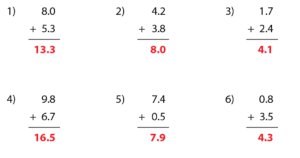
Decimal Addition worksheets free download pdf
1-DIGIT DECIMAL ADDITION (1 DECIMAL PLACE)

1-DIGIT DECIMAL ADDITION (1 DECIMAL PLACE)
1-DIGIT DECIMAL ADDITION(2 DECIMAL PLACE)

1-DIGIT DECIMAL ADDITION(2 DECIMAL PLACE)
1-DIGIT DECIMAL ADDITION (3 DECIMAL PLACE)

1-DIGIT DECIMAL ADDITION (3 DECIMAL PLACE)
2-DIGIT DECIMAL ADDITION(2 DECIMAL PLACE)

2-DIGIT DECIMAL ADDITION(2 DECIMAL PLACE)
3-DIGIT DECIMAL ADDITION(2 DECIMAL PLACE)

3-DIGIT DECIMAL ADDITION(2 DECIMAL PLACE)
4-DIGIT DECIMAL ADDITION(3 DECIMAL PLACE)

4-DIGIT DECIMAL ADDITION(3 DECIMAL PLACE)
5-DIGIT DECIMAL ADDITION(3 DECIMAL PLACE)

5-DIGIT DECIMAL ADDITION(3 DECIMAL PLACE)
Additionally, using online calculators or math worksheets can help you strengthen your skills. These tools provide instant feedback and boost your confidence over time.
In conclusion, whether you’re adding 1-digit or 4-digit decimal numbers, a clear method and consistent practice will help you succeed. Apply your skills daily, and you’ll soon handle decimal math like a pro!

